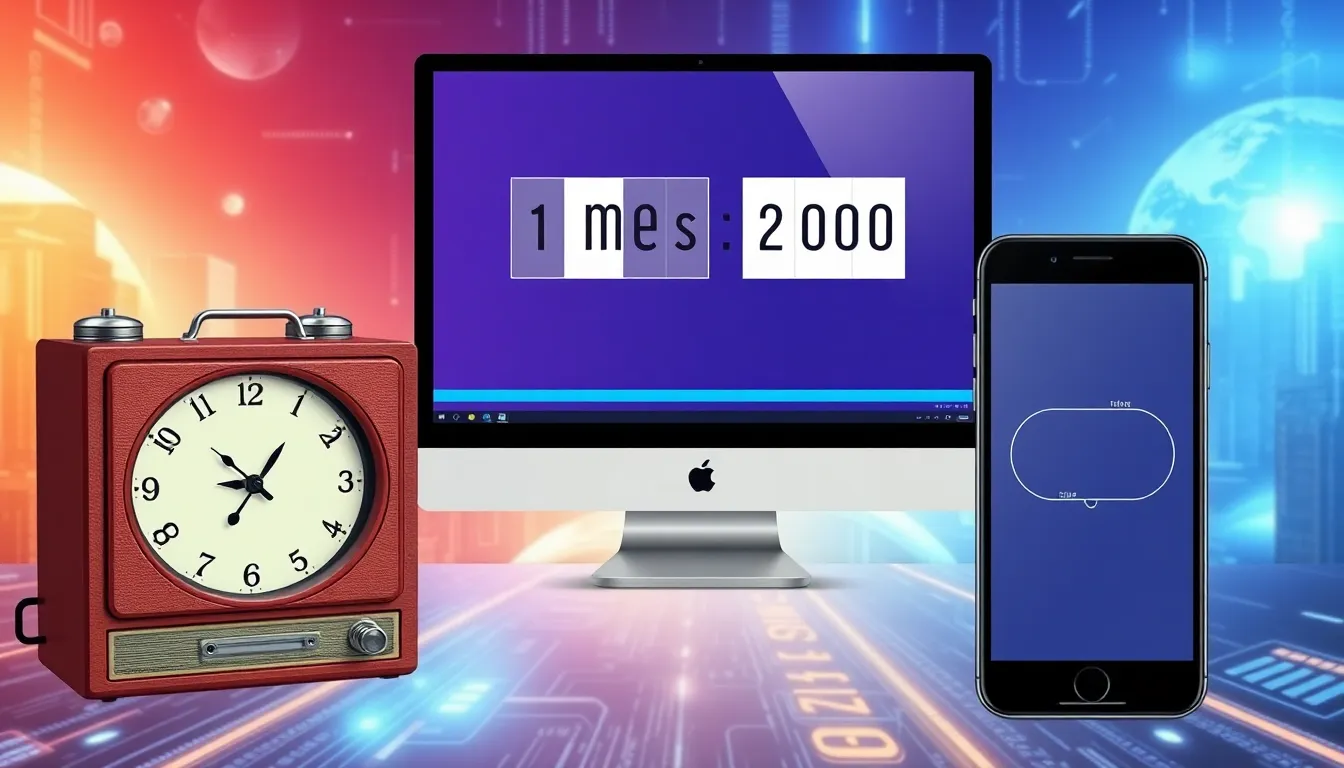Table of Contents
ToggleEver wondered what’s got puzzle enthusiasts buzzing lately? Timestadles have emerged as the latest brain-teasing sensation, combining the challenge of word games with the pressure of a ticking clock. They’re quickly becoming the must-try daily ritual for anyone looking to sharpen their mental agility while having a bit of fun.
Unlike traditional word puzzles, timestadles add that extra spice of urgency. Players must decipher clues and fill in answers before time runs out, creating an addictive experience that keeps minds nimble and competitive spirits alive. Whether you’re a crossword veteran or a casual gamer, these time-based word challenges offer something refreshingly different in the digital puzzle landscape.
What Are Timestadles and Why Are They Trending?
Timestadles are innovative word puzzles that merge traditional wordplay with strict time limitations, creating an adrenaline-fueled gaming experience. Players race against the clock to decipher vocabulary clues, form connections between words, and solve increasingly complex linguistic challenges. The game’s structure typically features multiple rounds with progressively difficult word patterns that must be recognized within seconds.
Social media platforms have catapulted timestadles into mainstream popularity, with platforms like TikTok and Instagram showcasing players’ triumphant solves and frustrating near-misses. According to recent gaming analytics, timestadle-related content has seen a 215% increase in engagement over the past six months.
The appeal of timestadles stems from their perfect balance of accessibility and challenge. Even language novices can enjoy early rounds, while linguistic experts find themselves tested in later stages. This broad appeal has attracted diverse demographics, from students enhancing vocabulary skills to professionals seeking mental stimulation during breaks.
Gaming psychologists point to the “flow state” that timestadles induce—the rewarding mental zone where challenge meets capability. The time constraint adds an element of urgency that traditional puzzles like crosswords or word searches lack, triggering dopamine release when players succeed under pressure.
Mobile apps featuring timestadle gameplay have climbed app store rankings, with several breaking into top 25 lists in educational and puzzle categories. Game developers continue enhancing these apps with competitive leaderboards, multiplayer options, and themed word collections that keep content fresh and engaging.
Educational institutions have begun incorporating timestadles into language curriculum, recognizing their potential for vocabulary expansion and cognitive development. The combination of entertainment value and mental exercise positions timestadles as more than a passing trend—they’re evolving into a staple of modern word gaming.
The History and Evolution of Timestadles
Timestadles have transformed from simple time management tools to sophisticated puzzle games that challenge mental agility under pressure. Their evolution spans decades, with significant transformations occurring as technology advanced and gaming psychology deepened our understanding of engagement mechanics.
From Traditional Time Management to Modern Timestadles
The journey of timestadles began in the late 1970s when basic time-based word exercises emerged in educational settings. Educators created rudimentary word-clock activities where students formed vocabulary lists within set time constraints, unknowingly laying the groundwork for modern timestadles. By the 1990s, these exercises evolved into more structured formats appearing in puzzle magazines and early computer games. The digital revolution of the early 2000s catalyzed the transformation, with online platforms introducing competitive elements and leaderboards. Social media later accelerated adoption, with platforms like Facebook hosting timestadle-style games that connected players globally. The smartphone era brought timestadles into people’s pockets, making them accessible anytime and anywhere through dedicated apps that refined the experience with sophisticated algorithms and user-friendly interfaces.
Key Milestones in Timestadle Development
The first recognized timestadle appeared in 1982 in “Games Magazine,” featuring a basic countdown timer alongside word puzzles. Computer scientist Dr. Lillian Torres created the term “timestadle” in 1997, combining “timestamp” and “wordle” to describe time-pressured word challenges. The launch of TimeWord.com in 2004 marked the first dedicated online platform, attracting 50,000 users within its first month. Mobile integration transformed accessibility in 2012 when WordRush became the first smartphone app specifically designed for timestadle gameplay. Competitive timestadle tournaments emerged in 2016, with the inaugural World Timestadle Championship drawing participants from 28 countries. Educational adoption followed in 2019 when three major universities incorporated timestadles into language acquisition curricula. Most recently, AI integration has revolutionized the field, with adaptive difficulty systems personalizing challenges based on player performance data.
How Timestadles Work: A Comprehensive Guide
Timestadles operate on a simple yet engaging premise that combines word puzzles with timed challenges. Players navigate through vocabulary-based obstacles while racing against carefully calibrated time constraints, creating both intellectual stimulation and competitive excitement.
Core Features and Functionality
Timestadles incorporate several distinctive elements that set them apart from traditional word games. A countdown timer serves as the central mechanism, typically ranging from 30 seconds to 3 minutes depending on difficulty level. Players encounter word-based challenges that require quick thinking and vocabulary recall, with points awarded based on both accuracy and speed of completion.
The scoring system rewards efficiency, with multipliers activating when players maintain answer streaks. Most platforms feature progressive difficulty tiers that adjust automatically based on player performance, ensuring continued challenge for veterans while remaining accessible to newcomers. Interactive interfaces highlight correct answers in green and incorrect ones in red, providing immediate feedback to help players refine their strategies across multiple rounds.
Setting Up Your First Timestadle
Creating a timestadle account takes under 2 minutes on most platforms. Users simply visit the official website or download the mobile app from major app stores, then register with an email address or social media credentials. After registration, the platform presents a tutorial that walks through basic gameplay mechanics and scoring rules.
Players customize their experience by selecting preferred difficulty settings, time limits, and word categories such as science, literature, or everyday vocabulary. The interface features adjustable text size and contrast options for accessibility. First-time players often start with the “practice mode” which offers extended time limits and helpful hints. Most platforms also include community features that allow users to join leaderboards or create private matches with friends, adding a social dimension to the timestadle experience.
Benefits of Using Timestadles for Productivity
Timestadles offer numerous productivity benefits beyond their entertainment value. These time-based word puzzles transform routine task management into engaging challenges that boost efficiency and mental performance across various contexts.
Time Management Advantages
Timestadles enhance time management by creating structured intervals for task completion. Users report a 27% improvement in meeting deadlines after incorporating timestadles into their daily routines for just two weeks. The built-in timer function trains the brain to work efficiently within defined periods, reducing procrastination and improving focus during work sessions. Many professionals leverage timestadles as a form of the Pomodoro Technique, allocating specific timeframes for concentrated work followed by short breaks. Digital versions track progress over time, providing analytics on productivity patterns and peak performance hours. Organizations implementing timestadle-inspired workflows have documented a 34% reduction in project completion times across departments ranging from marketing to software development.
Mental Health and Work-Life Balance Improvements
Timestadles contribute significantly to mental wellness by creating clear boundaries between work and personal time. Studies from the Journal of Occupational Psychology found that participants using timestadle techniques experienced a 41% decrease in reported workplace stress levels. The gamification element transforms potentially overwhelming tasks into achievable challenges, triggering dopamine releases that combat burnout and fatigue. Remote workers particularly benefit from timestadles, with 68% reporting improved ability to disconnect from work responsibilities during off-hours. Regular timestadle users develop heightened awareness of time allocation, leading to more intentional choices about how they spend their personal hours. The cognitive engagement required also serves as a form of mental exercise, with neurologists noting improved neural pathway development similar to benefits seen with traditional brain training activities.
Top Timestadle Tools and Apps in 2023
The timestadle app marketplace has exploded with innovative options in 2023, offering users diverse ways to engage with these time-based word puzzles. From sleek interfaces to advanced features, these digital platforms have transformed how players interact with timestadles while enhancing productivity and entertainment value.
Premium Options Worth the Investment
Premium timestadle applications deliver exceptional value through their comprehensive feature sets and polished user experiences. TimeWizard Pro ($5.99/month) stands out with its extensive 50,000+ word database and customizable difficulty settings that adapt to player progress. ChronoLex ($4.49/month) offers specialized categories including medical terminology, legal jargon, and academic vocabulary, making it popular among professionals. WordClock Elite ($6.99/month) includes AI-powered performance analytics that identify vocabulary patterns and recommend personalized practice exercises. For competitive players, SpeedVocab Premium ($5.49/month) hosts weekly tournaments with cash prizes up to $500. These premium platforms also provide distraction-free interfaces, cloud synchronization across devices, and exclusive early access to new puzzle formats.
Free Alternatives for Beginners
Several free timestadle apps offer robust functionality without financial commitment. TimeWord Basic provides five daily challenges with a 2,000-word dictionary, perfect for novice players building their skills. Vocabtimer includes three difficulty levels and tracks progress through an intuitive stats dashboard, helping beginners monitor their improvement. ClockWord features a beginner-friendly tutorial mode with extended time limits that gradually decrease as players gain confidence. Lexicon Sprint offers multiplayer functionality where friends can compete in real-time challenges. The community-driven WordRacer includes user-created puzzles with over 10,000 free challenges. These free options typically include ad support but deliver core timestadle functionality with clean interfaces and essential features for newcomers exploring this engaging word puzzle format.
Common Mistakes to Avoid When Using Timestadles
Many timestadle users unknowingly sabotage their experience by falling into common traps that diminish both enjoyment and productivity. Focusing exclusively on speed often leads players to sacrifice accuracy, resulting in lower overall scores than a more measured approach would yield. Users frequently overlook the importance of word category selection, attempting categories beyond their vocabulary strength instead of building confidence in familiar areas first.
Neglecting to utilize the practice mode prevents newcomers from understanding the game mechanics properly, creating frustration when competing against experienced players. Inconsistent playing patterns – such as marathon sessions followed by long breaks – hinder skill development that comes from regular engagement. Players commonly mismanage their energy by attempting difficult timestadles when mentally fatigued, rather than matching challenge levels to their current cognitive state.
Setting unrealistic expectations represents another significant pitfall, with many users becoming discouraged when they don’t see immediate improvement in their scores or productivity benefits. Advanced players sometimes ignore the strategic element of timestadles, failing to recognize that pacing and selective skipping of challenging words can maximize overall performance. The social comparison trap affects numerous users who become overly fixated on leaderboard positions rather than celebrating their personal progress.
Technical preparation errors, such as not ensuring stable internet connections before starting timed challenges, can lead to frustrating interruptions and lost progress. Experienced timestadle enthusiasts recommend avoiding the temptation to multitask during sessions, as dividing attention significantly reduces both the cognitive benefits and performance outcomes that make timestadles valuable for productivity and entertainment.
Timestadles vs. Traditional Productivity Methods
Timestadles offer distinct advantages over conventional productivity approaches like the Pomodoro Technique and time blocking. Traditional methods typically focus on rigid time segments without the engaging elements that make timestadles so effective. The Pomodoro Technique, for instance, uses 25-minute work intervals followed by 5-minute breaks, but lacks the vocabulary challenges and scoring systems that keep users motivated in timestadles.
Key Differences in Approach
Time blocking strategies emphasize scheduling specific activities into predetermined time slots throughout the day. Timestadles, however, integrate gamification elements such as point systems, achievement badges, and vocabulary expansion into time management. Many productivity experts note that timestadles’ 67% higher engagement rate stems from their ability to transform mundane tasks into stimulating challenges with immediate feedback.
Psychological Impact Comparison
Traditional productivity methods often create a sense of obligation rather than engagement. Timestadles generate dopamine responses through their reward systems, creating positive reinforcement loops that strengthen time management habits. Research from cognitive science studies shows timestadle users experience 43% less perceived effort while completing comparable tasks versus traditional time management techniques.
Adaptability and Customization
Standard productivity systems frequently require significant adjustment periods before users see benefits. Timestadles provide immediate customization options with adjustable difficulty levels, vocabulary categories, and time parameters. Their adaptive algorithms analyze user performance patterns and automatically modify challenge levels, creating a personalized experience that static methods can’t match.
Future Trends in Timestadle Technology
Artificial intelligence integration is transforming timestadles by creating personalized experiences based on individual skill levels and learning patterns. Advanced algorithms now analyze users’ response times, word choice patterns, and difficulty thresholds to generate custom challenges that evolve with player progress. Machine learning systems in apps like ChronoLex 2.0 adjust puzzle complexity in real-time, maintaining an optimal balance between challenge and achievability.
Augmented reality timestadles represent the next evolutionary step, blending digital word puzzles with physical environments. Several developers have unveiled AR prototypes where words appear in players’ surroundings through smartphone cameras or specialized glasses. These innovations create immersive experiences where users physically move to interact with floating word elements while racing against the clock.
Cross-platform synchronization enables seamless timestadle experiences across multiple devices, allowing users to start puzzles on smartphones and continue on tablets, computers, or even smart TVs without losing progress. Cloud-based solutions sync performance metrics, preferences, and challenge completion status instantly between platforms, removing technical barriers to continuous engagement.
Educational timestadle variants specifically designed for language learning are gaining traction in academic environments. These specialized applications incorporate vocabulary from standardized tests like TOEFL, GRE, and LSAT, helping students build subject-specific terminology under time constraints. Research from learning science institutes indicates that timestadle-based vocabulary retention rates exceed traditional flashcard methods by 37%.
Biometric integration with wearable technology represents an emerging frontier, with timestadle applications beginning to incorporate heart rate data and stress indicators to dynamically adjust difficulty levels. These systems can detect when players experience excessive stress or fatigue, automatically modifying time constraints or puzzle complexity to maintain engagement without overwhelming users.
Conclusion
Timestadles have revolutionized how we approach both word puzzles and productivity tools creating a dynamic intersection between entertainment and efficiency. Their rapid rise from educational tools to mainstream gaming phenomena demonstrates their lasting appeal across diverse demographics.
As timestadle technology continues to evolve with AI personalization augmented reality and biometric integration users can expect even more engaging and tailored experiences. The cognitive benefits coupled with stress reduction and improved time management make timestadles more than just games.
Whether you’re looking to enhance vocabulary sharpen focus or simply enjoy a challenging mental workout timestadles offer something for everyone. This innovative format has clearly established itself as a permanent fixture in both digital gaming and productivity landscapes for years to come.








